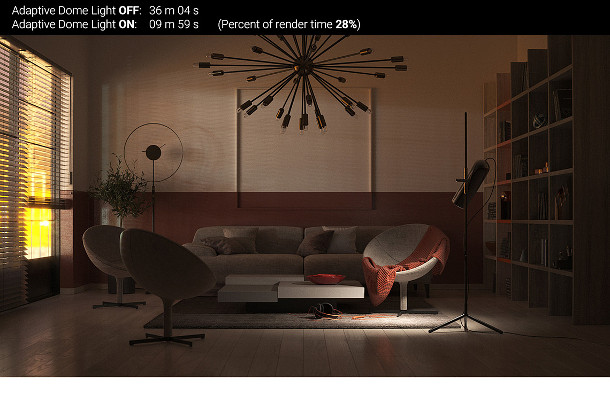Chaos Group releases Beta 1 of V-Ray Next for 3ds Max

Originally posted on 15 December 2017. Scroll down for updates.
Chaos Group has released the first beta of V-Ray Next for 3ds Max, the next major update to the renderer.
The release – it’s effectively V-Ray 4.0 under a different code name – is described as a major overhaul of the software’s two-decades-old code base, initially focusing on core workflow tools.
Changes in Beta 1 include ‘smart features’ like a new adaptive dome light and auto exposure system; a new hair shader and switch material; and updates to the physical camera, render denoising, and GPU rendering.
A ‘comprehensive clean-up of an ageing code base’
In a post on LinkedIn, Chaos Group ‘trouble stirrer’ Emmanuele Lecchi describes V-Ray Next as a “comprehensive clean-up and refactoring” of V-Ray’s “ageing” code base.
“In years past [development] work was often frustrated by limitations stemming from old compromises which had to be made years before,” he writes. “Next unshackles [our] programmers from all that luggage.”
Lecchi describes the work as “starting from things you will spend most of your time with: your tools to light and shade, their UIs and behaviours, the VFB, IPR and ancillary tech [and] easier portability across DCCs.”
New light cache analysis-based ‘smart features’ include a new Adaptive Dome Light
Although Lecchi’s post pitches Beta 1 as primarily a test to see whether the new architecture breaks any existing core functionality, there are also a number of new features.
Several are what Chaos Group Labs director Christopher Nichols describes as a new generation of ‘smart features’ that analyse light cache data to optimise sampling as a scene renders: an approach recently used in V-Ray 3.5’s Adaptive Lights system.
Beta 1’s Adaptive Dome Light applies the principle to the HDR dome used for image-based lighting, using the light cache calculation phase to analyse which parts of the dome light are most likely to affect a scene.
Focusing samples in those key areas results in cleaner, faster renders: Chaos Group’s internal benchmarks render 1.1 – 3.6x faster on a high-end test machine when the Adaptive Dome Light is activated.
Nichols says that the new system also makes it unnecessary to use workarounds like manually placing Skylight Portals near windows and doors in interior scenes – and indeed, the biggest speed boosts in Chaos Group’s published tests are on the interior benchmarks.
Other features in Beta 1 that use scene analysis include a new auto exposure and white balance system.
Updates to the physical camera, render denoising and GPU rendering
The new auto exposure system is supported in V-Ray’s Physical Camera, which now features a simplified UI.
The render denoising system introduced in V-Ray 3.4 has also been updated, making it possible to denoise any render element as well as the beauty pass: a feature also recently implemented in cebas’s finalRender.
GPU rendering has also been extended, if not to the across-the-board levels of finalRender, with interactive renderer V-Ray RT now officially renamed V-Ray GPU and getting support for environment fog and VRscans.
New hair shader, switch material and plugin material
V-Ray Next Beta 1 also adds a new hair shader with melanin colour controls and a “more natural light distribution”, and a switch material for switching between a number of materials applied to an object.
The latter is intended for randomising materials across objects or rendering variant looks of a scene.
There are also a new plugin material and texture, which should make it possible to use any material or texture available in the standalone edition of the renderer within 3ds Max.
Updated 22 January 2017: Chaos Group has now updated its blog with detailed posts on V-Ray Next’s new auto exposure system and improved render denoising using Nvidia’s GPU-based OptiX technology.
Chaos Group co-founder Vlado Koylazov has also posted a video of an early build of the new V-Ray Frame Buffer (above), showing the new history list implementation and compositing controls for render elements.
Pricing and availability
V-Ray Next Beta 1 is available to users of V-Ray 3.x for 3ds Max. You can apply to join the beta here. Chaos Group says that more new features will be rolled out in future beta releases.
The current release of the software, V-Ray 3.6 for 3ds Max, is available for 64-bit 3ds Max 2013 and above. New licences start at $1,040 for one floating user licence and one floating render node licence.
Read a full list of new features in V-Ray Next Beta 1 for 3ds Max on the product website
Read an overview of V-Ray Next’s development philosophy in Emmanuele Lecchi’s post on LinkedIn
Read more about the individual features in V-Ray Next on the Chaos Group Labs blog
